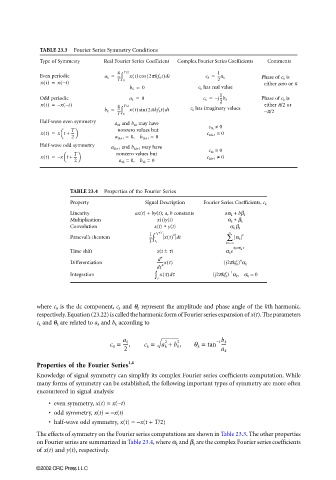Page 705 - The Mechatronics Handbook
P. 705
0066_Frame_C23 Page 13 Wednesday, January 9, 2002 1:53 PM
TABLE 23.3 Fourier Series Symmetry Conditions
Type of Symmetry Real Fourier Series Coefficient Complex Fourier Series Coefficients Comments
Even periodic a k = 4 --- ∫ T/2 xt() cos ( 2πkf 0 t) td c k = 1 --a k Phase of c k is
xt() = x –() T 0 2 either zero or π
t
b k = 0 c k has real value
1
Odd periodic a k = 0 c k = – j--b k Phase of c k is
xt() = x – –() 4 T/2 2 either π/2 or
t
b k = --- ∫ xt() sin ( 2πkf 0 t) td c k has imaginary values −π/2
T 0
Half-wave even symmetry
a 2k and b 2k may have
c 2k ≠ 0
nonzero values but
xt() = xt + T a 2k+1 = 0, b 2k+1 = 0 c 2k+1 = 0
---
2
Half-wave odd symmetry a 2k+1 and b 2k+1 may have c 2k = 0
xt() = x – t + T nonzero values but c 2k+1 ≠ 0
---
2
b 2k = 0
a 2k = 0,
TABLE 23.4 Properties of the Fourier Series
Property Signal Description Fourier Series Coefficients, c k
Linearity ax(t) + by(t); a, b constants aα k + bβ k
Multiplication x(t)y(t) α k ∗ β k
Convolution x(t) ∗ y(t) α k β k
1 t 1 +T 2 ∞ 2
Parseval’s theorem --- ∫ xt() d t ∑ α k
k=∞
–
T t 1
j ± 2πf 0 τ
Time shift x(t ± τ) α k e
n
d
n
Differentiation -------xt() (j2πkf 0 ) α k
dt n
−1
Integration ∫ x τ() τd (j2πkf 0 ) α k , α 0 = 0
T
where c 0 is the dc component, c k and θ k represent the amplitude and phase angle of the kth harmonic,
respectively. Equation (23.22) is called the harmonic form of Fourier series expansion of x(t). The parameters
c k and θ k are related to a k and b k according to
c 0 = a 0 c k = a k + b k , θ k = tan ----
2
2
–
1 b k
----,
2 a k
Properties of the Fourier Series 1,4
Knowledge of signal symmetry can simplify its complex Fourier series coefficients computation. While
many forms of symmetry can be established, the following important types of symmetry are more often
encountered in signal analysis:
• even symmetry, x(t) = x(−t)
• odd symmetry, x(t) = −x(t)
• half-wave odd symmetry, x(t) = −x(t + T/2)
The effects of symmetry on the Fourier series computations are shown in Table 23.3. The other properties
on Fourier series are summarized in Table 23.4, where α k and β k are the complex Fourier series coefficients
of x(t) and y(t), respectively.
©2002 CRC Press LLC

